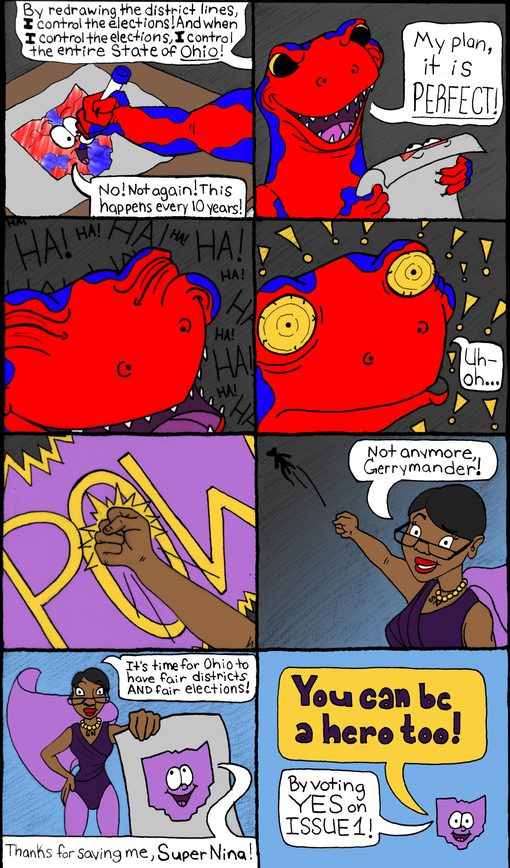The two parties have largely built a stacked deck resembling a house of cards when it comes down to determining the winning presidential candidate. In the national context, this house of cards is an Electoral College decided by one swing state like Ohio. And in Ohio, that stacked deck is a districting process where Ohioans' interests gets lost in the shuffle.
Ohio really has some of the most beautiful sprawling countryside that you'll see in America, and the state's populace reflects national diversity trends. The state has been such a bellwether for how other Americans think, politicians and journalists rely on the adage, "As Ohio goes, so goes the nation." But a fair reflection of this uniquely American body politic has long been prevented by the contortion of voting districts into warped gambits that guarantee re-election for lazy politicians.
This decisive state is not laid out into voting blocs like the block-shaped map of the United States. The electoral map of Ohio looks like shattered glass. Winding chunks drawn out into long thin slivers, the decision making behind this districting was so clearly driven to ensure safe re-election, these broken boundaries should be evidence of a crime. Cities, counties, municipalities -- none of these natural choices for civic representation are taken into account, it's purely based on creating districts around likely voters. And that is known as gerrymandering.
Why is it called gerrymandering? A governor of Massachusetts, Elbridge Gerry, redrew his state's districts so imaginatively in 1812, one was said to resemble a salamander. Unfair apportionment happens in other parts of the world, but this term is used for it, another export of American democracy. (Although Gov. Gerry pronounced his name "Gary," it's up to you if you want to correct people who pronounce it "Jerry-mandering").
It's hard to put back together a broken system. But it's also hard to get anything done when elected leaders are incentivized to be bellicose and stubborn instead of cooperative, because they know obstructionism plays well in their specially drawn district. A handful of these cranks in Congress can shut down the federal government, and have.
And so when this important issue finally got on the ballot as Issue One, Common Cause Ohio set out to make the issue more relatable to the public. Picking up on the theme of "Activist Comics," The Fair Districts=Fair Elections Coalition held a competition for Ohioans to create their own cartoons about the importance of fighting gerrymandering, which Issue One does on a variety of fronts: It creates a bipartisan commission, a ban on partisan redistricting, a requirement that districts reflect how voters have voted and it does this by amending the state's constitution.
The winner has been announced: Samantha Archual's "Gerymander v. Super Nina," which features Nina Turner, a state legislator and frequent quest on MSNBC, who voted to put Issue One on the ballot. "Redistricting reform is one of the most important issues we can tackle,'' Turner said. "It's my hope that Super Nina will inspire the voters of our great state to vote YES on Issue 1 so they all can be super heroes too.''
Samantha Archual is a senior 2-D Animation Major at the Columbus College of Art and Design, who is also minoring in Creative Writing and is currently on track to graduate with Honors. In 2012, she became heavily involved in Barrack Obama's political campaign, knocking doors, phone-banking, organizing campus events and acting as "Campus Team Leader/Logistics Manager" for the campaign as well. This volunteer experience opened her eyes to the importance of voting as well as maintaining her civic duty of staying politically-conscious! She is currently an intern with Democratic Voices. (To see some of Samantha's art work, visit her blog at samarchual.wordpress.com)
Samantha explained why she felt compelled to participate in this contest, "When I learned about gerrymandering -- I was extremely shocked that this has been a norm in Ohio for as long as it has! Gerrymandering inherently threatens our democratic process and, by spreading awareness about why people should support Issue 1, we are beginning the process of getting our democracy back on track. Ohioans deserve FAIR districts and FAIR elections and voting yes on Issue 1 is the first step to finally eradicating that villainous 'Gerrymander' once and for all!"
Second Place went to Eduardo Calzadilla for "Miss Fair vs. Gerry Mander" and Third Place went to Catherine Fastenau for "Lady Justice." You can see their entries at ActivistComics.org, along with other reform-fueled art.
To reinvent our country, we will have to reimagine Ohio from the ground up. Art can be essential to that vision. I don't know that we can change the Constitution, the Electoral College or widespread voter apathy. But I know we can change Ohio. The Buckeye state is the heart in the heartland of America.
John Wellington Ennis's documentary PAY 2 PLAY: Democracy's High Stakes follows outsiders fighting the two party system in Ohio, and his new book Where Else But The Streets chronicles political street art in Los Angeles, including Activist Comics.

